If you’re unfamilar with the INDependent subway, IND stations are instantly recognizable in contrast to BMT and IRT stations, which were built earlier. In fact, I’m beginning to hear from people who no longer know the old subway divisions, which is understandable since the subways have, since 1940, been consolidated in the same system — which has had a number of names through the years, now the Metropolitan Transit Authority. Younger riders, except for train buffs, are now confused by the terms IRT, BMT, IND.
The 5-cent history is this: the first subway, which ran from City Hall to Broadway and 145th Street and opened in October 1904, was constructed by a company called Interborough Rapid Transit, even though the first route was Manhattan-only. Soon, lines were built into Brooklyn, justifying the name. Beginning in the 1910s, a company called Brooklyn Rapid Transit built a network of surface lines and subways between Brooklyn and Manhattan; when that company went bankrupt after a train crash in a tunnel at Malbone Street, Brooklyn, in 1918, it reorganized as Brooklyn-Manhattan Transit, or the BMT. Finally, in the mid-1920s, the City of New York began planning and building its own set of subway lines, called the Independent.
Despite consolidating in 1940 the three branches remain remarkably distinct. While the BMT and IND trains can run on each others’ lines since the cars are the same width and the platforms the same width, neither of those lines can run on IRT trackage, since its cars and platforms are narrower. At the same time, there are few points of exchange between what were the IND and BMT. One of them is a connection under Chrystie Street in Manhattan, idle for years but now used by the M train. When that connection was built [see Comments], it enabled both BMT and IND trains to run up 6th Avenue. There are no track connections between Manhattan/Brooklyn IRT trains and the other two divisions, although the Flushing IRT line has a track connection with the Astoria BMT line at Queensboro Plaza. The two lines were once run jointly by the BMT and IRT.
Within Bronx and Brooklyn trainyards, there are connections between the BMT and IRT [see Comments]
IND stations were built in cavernous fashion, apparently in reaction to the cramped quarters some IRT stations have to this day. This is somewhat inconvenient at times — getting to the platform sometimes takes so much time that you miss the train.
In early 2009 in Brooklyn Heights, I got a few pictures of the High Street station, typical of the IND local stations in Brooklyn.
Getting to the platform stairway takes awhile.
Finally there….
R-40 slant front cars have now been retired. They were introduced in the late 60s with bare slant ends, which were deemed dangerous for people passing between cars (now officially prohibited); gates were later installed. nycsubway.org
The IND’s tiled signage scheme has remained unchanged for the most part for the last 7 decades. In the 1930s, Fulton Street ran continuously from the East River to the Brooklyn-Queens line in Cypress Hills, but when in the 1950s, when Cadman Plaza, a large downtown park, was built, the portion of Fulton Street adjoining it was renamed Cadman Plaza West.
The High Street station was built deep underground. I wonder if an escalator was in place when the station was opened on February 11, 1933.
The station has exit/entrances on Fulton (Cadman Plaza West) and Cranberry, as well as Washington (Cadman Plaza East) and High (Red Cross Place). Downtown Brooklyn was a vastly different place when the IND opened here in 1933. Since then, entire blocks have given way to housing projects and expressways, and some streets remaining in place have been renamed. High Street, which used to run from Fulton Street east to Navy Street at the Brooklyn Navy Yard, was decimated and only two short stretches remain. A short piece between Washington and Adams was renamed Red Cross Place in the 1950s, as the Brooklyn headquarters of the worldwide relief agency was located there.
Thus, the High Street station is no longer on High Street.
The St. George Hotel was once one of the prime meeting spots in Brooklyn Heights, on Henry and Clark Streets. At one time the nation’s largest saltwater swimming pool as well as the world’s largest banquet hall were featured. The IRT 7th Avenue line are still entered from the hotel lobby. The St. George became a co-operative apartment complex after several years of decline in the 1990s.
Looks like a light in the distance.
The fresh and wholesome air of Brooklyn Heights, reattained.
3/22/12

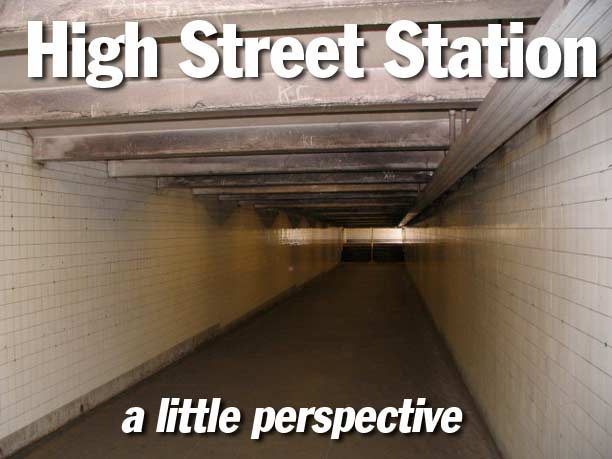



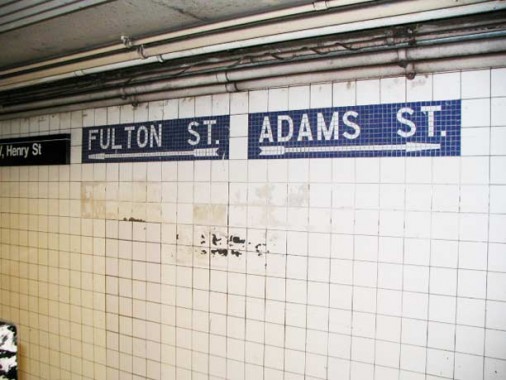

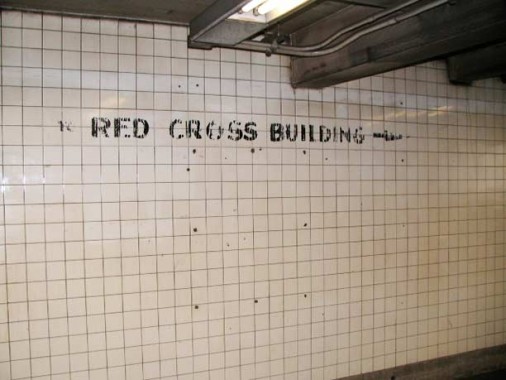
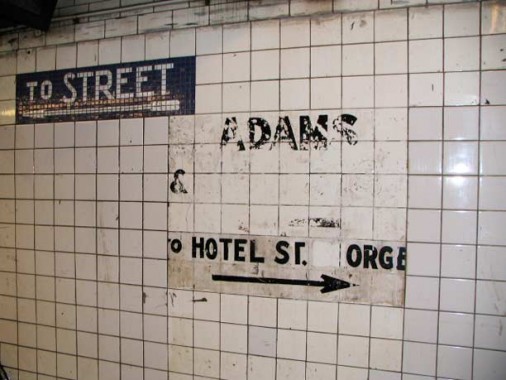
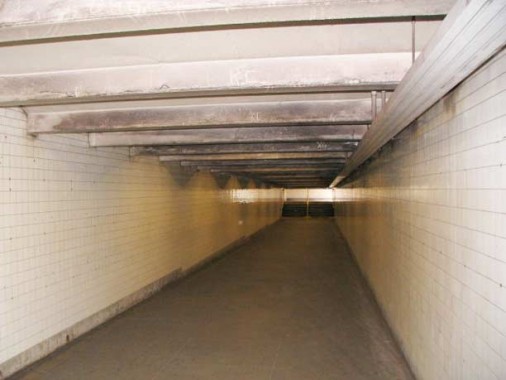
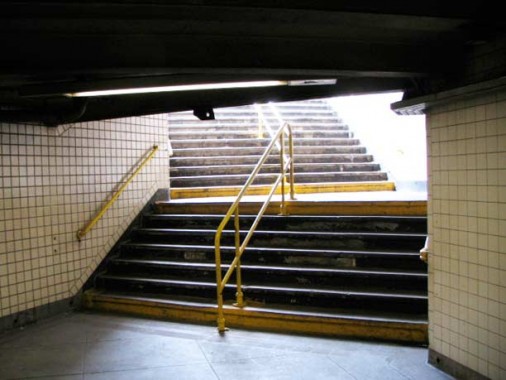

46 comments
Your text:
“One of them is a connection under Chrystie Street in Manhattan, idle for years but now used by the M train. When that connection was built in 1967, it enabled both BMT and IRT trains to run up 6th Avenue.”
This text may contain a typo. You may have meant “it enabled both BMT and IND trains to run up 6th Ave.” Have never seen any IRT trains in 6th Ave IND stations. You have a fantastic site. Did not know about the connection under Chrystie Street.
Thanks
Another connection is the one from the old BMT 60th Street tunnel to the IND Queens line, opened in December of 1955. It enabled the Brighton Local to run into the IND at its Queens Plaza station. The R follows this connection today.
And don’t forget the 1954 connection/extension of the IND Brooklyn line from Church Avenue to the old Culver line station at Ditmas Avenue and then down McDonald Avenue to Coney Island. That one ended BMT use of the line from Ditmas to CI.
Do not forget the non-revenue connection between the BMT/IND 63 Street lines at Lex Av-63 St.
This station (along with a few others) are the closest stations we have to the London Underground. Way down in the depths via escalators of considerable length, true tube walls and roofs. This station is even called High Street, High Street being a known thoroughfare in London and a frequent name for prominent streets in England.
Any station that’s near the river to be navigated underwater will always be relatively deep underground. That’s so there won’t be too much of a climb from the underwater tube to the nearest stations
That’s an ironic statement because some of the London Underground Stations are cut and cover close to the surface.
I think High Street was also the location of a free transfer between the IND subway and the B67/69/75 bus routes that was set up in the early 1950s after streetcar service over the Brooklyn Bridge was eliminated. It wasn’t marked on any maps but managed to survive until the late 1980s.
There were two parts to Chrystie St. The part that connects DeKalb Ave and the 4th Ave/Coney Island lines and Grand St, Manhattan has been in continuous use (except for times that the Manhattan Bridge reconstruction was being done) since November 1967.
The part that the M train uses today was first put into service in July 1968 when the 57th/6th station opened along with the express tracks between West 4th and 34th/6th. The KK and briefly the K train used those tracks. The service was canceled by the mid 1970’s for lack of ridership. Passengers would rather ride the QJ or later J express trains to Essex and wait for a F train to 6th Ave than ride the local KK or K.
People seem to favor crowded expresses over empty locals every time. I like the room.
I agree with Kevin on this one. To travel from Brooklyn Bridge to 125th Street on the IRT Lexington line, there are only a few minutes difference between the express 4&5 and the local 6.
Good to know the fate of the St. George Hotel. When I was a Boy Scout (Troop 92, Bronx) one of our favorite winter outings was a trip to the St. George pool. It was heated & there were several diving boards. We had such great times that we forgot about the swimming merit badges that we were supposed to be earning. 50 years later most swimming pools lack diving boards & life guards have been replaced by “monitors” who yell “no running” when kids attempt to enjoy themselves. Thanks for the memories.
Can recall when the R-40s rolled out on the F train.
One morning on the way to school a nice shiny one appeared at the 179th st station, and as the announcer let us know about it he added, “No dancing in the isles”. (there used to be an airline commercial that used that punchline)
Indeed. Olympic Airways.
I remember when I was a kid back in the 60’s the high street station had wooden escalators.
The train crash referred to was a real tragedy; the entire story is detailed in an excellent book entitled; “The Malbone Street Wreck” by Brian Cudahy. It has been called the greatest mass transit accident in the history of the U.S. The book is available at Amazon and Barnes & Noble.
http://www.barnesandnoble.com/w/malbone-street-wreck-brian-cudahy/1100867224
If you talked about The Malbone Street Wreck,I heard of it,since I was young.For photos of the wreck,visit nycsubway.org for the photos.Trust me.Crash is devasating.Never forget those lost 93 lives.Rest in picece.:(
“There are no track connections between Manhattan/Brooklyn IRT trains and the other two divisions”
That’s not true, as there are multiple track connections between IRT and IND systems inside the 207th St Yard in Manhattan and Concourse Yard on the Bronx. There is also a non-electrified connection (for diesel work trains) connecting the 3 and the L lines near the Linden Yards in Brooklyn.
There was a BMT / IRT connection at Queensboro Plaza when the lines were built under the “Dual Contract”. In fact, you travel on the same train between Flushing and Astoria. That original station was eight tracks, but was reduced to the current four when the northern half of the structure was demolished fifty or sixty years ago. In the current configurarion, the Manhattan-bound Astoria and Flushing trains share different sides of the same platform upper-level platform and the Astoria-bound and Flushing-bound trains share the same lower-level platform, but the tracks do not connect.
Looking at Peter Dougherty’s full system track map, there is still a track connection a bit to the East of Queensboro Plaza. It makes sense, there does need to be a way to get cars on & off the Flushing line for delivery or service. Also, the BMT and IND connect at Church Avenue, as the current F trains use the Culver Line south of there, which connects to the rest of the BMT via Coney Island Yards.
The R-40 slants were introduced in 1968, not the “early 60s”. Otherwise, great piece.
Noted …
Even though part of High Street where the station stands is no longer there, it didn’t mean that it never did have entrance on High Street originally. Still, I don’t know why that part was renamed, but that’s politics for you. However, there is a subway station that has the name of street, but has no entrance on that said street at all, and that W 4th Street-Washington Square over in Greenwich Village. Despite its name, there is literally no entrance on 4th Street at all, it’s actually actually a block down on 3rd Street for some reason.
Wooden escalators? Wow! I didn’t think they had those.
Wooden escalators? Wow! I didn’t think they had those.
The old subway escalators I remember were made of wood. Two locations I recall are 34th St & 6th Ave and Atlantic Ave. (B) (Q) . There were much more locations. The stainless steel versions came much later to replace the original wooden escalators.
Now imagine subway stations with incandescent lighting to go along with wooden escalators !
I would say,the subway could be a different place in New York.
When were the last wooden escalators removed from New Yorks’s subways? Did they come up earlier, or did they basically react to London’s “Fennel Report” after the fire of 1987 which laid the blame for the King’s Cross fire completly on the actually-quite-reliable wooden escalators? (ignoring a bunch of other factors, including accumulated junk underneath said escalator dating to the 40’s, and an idiot dropping an improperly extinguished cigarette, oh, and a state-of-the-art fog fire supression system….that didn’t work, and wasn’t regularly checked before hand!)
I rode the subway from around 1960 to 1981, and seem to remember wooden escalators on the IND Fifth Ave. (53rd Street) and 145th Street (Bronx) stations. (And yes, Macy*s 34th Street and perhaps Gimbel’s across the street had them too.)
Now THAT (the wooden escalator) sounds like London!
High Street is really a very atypical IND station because of its depth from street level, and long passageways between the mezzanine and escalators. Typical IND stations have stairs from street corners into a mezzanine and a fare control area, then stairs down into the station iteself. Good examples – the local stations on the Queens Blvd. line between Grand Avenue and 67th Avenue; and the Grand Concourse line at 183rd Street.
I remember very well what a big deal it was when the Chrystie Street Connection became a reality in 1967. Before that, the IND and BMT (and IRT) really were totally separate, and NYC Transit maps showed the three divisions as three distinct colored lines. It was because of the Chrystie St. tunnel and the rerouting of former BMT trains onto IND tracks (or was it the other way around?) that the whole system of line designations we know today — the letters in colored circles — came into being.
As a kid in the 70’s I seem to recall older relatives referring to train lines by the names BMT and IRT etc. I had no idea what they meant. All I knew was I got on the RR at Ditmars.
In Brooklyn, we had the 4th Avenue, Culver (McDonald Ave.), Sea Beach, West End, and Brighton Beach lines. I have no idea what their letters/numbers are today, and don’t recall ever riding on the IRT! That was the 50’s/60’s.
Sea Beach = N
West End = D
Brighton Beach = Q and B
Culver = F
4th Avenue = R
Another reason for the extremely long mezzanine passagways is that the High Street station runs perpendicularly under the approach to the Brooklyn Bridge that empties into Adams Street. The Cadman Plaza exit and Washington Street exit are on respectively the west and east sides of the ramp. Having a connecting mezzanine allows passengers from either entrance access to the one fare-control area.
The Union Turnpike/Kew Gardens E./F station is also bisected by a major roadway, in this case the Jackie Robinson n/e/e Interborough Parkway. But there are two separate mezzanines and fare control areas. And it’s a simple matter to walk between them on street level along Queens Boulevard.
So you must know how odd it looks at street level, just north of Queens Blvd., where you can see the windows (or cutouts) as the road turns into the Jackie Robinson (which I still think of as the Interborough Pkwy.). I was always fascinated by this and guess it is the mezzanine area just as you describe.
I remember when lines were still called by the company names IRT, BMT and IND, and that was in the 80’s.
I have an old sign that used to be hung on the front of MUDC cars and it has IRT on one side and BMT on the other-they switched it depending on what service the 2nd Avenue El was running.
I left NYC many years ago,but I recall growing up in what was electric transit buff’s paradise in the 50’s in Brooklyn.We still had some streetcars;a nice trackless trolley system;and I lived not too far from a triple level trainwatching spot at Pitkin and Van Sinderen-the Fulton Street El “C”units curving over to run down Pitkin on top;the Canarsie Line with Multis in the middle;and the Bay Ridge branch heavy electric in the open cut below.
The Brooklyn line of the IRT came to the surface two blocks from my house and ran on an el down Livonia(still running)-Low V’s ruled the roost on the IRT in those days.
The BMT had the best cars and the most character of the three divisions.
I have visited this site quite often. Your photo essay on High Street has brought back some sweet memories for me. Growing up in the Farragut Houses our subway stop was both High Street and York Street. I favored the “A” line most often due to the connections at Broadway-Nassau Street station. where you can connect with both IRT and BMT. 42nd Street was good for us back then with the movies and Port Authority. The buses would give free transfer to the IND line there (B57, B62, B67, B69, and the B75). We had five bus lines terminals at High Street. Walking down that long hallway to the trains, riding down the wooden escalators, wonderful memories. Thanks truly enjoy your work.
Living in Florida for the past 20 years, anything having to do with the subways is a big treat for me, and brings back good memories. Thank you!
The R-40 Slants! My favorite subway train type. The only time I see them now is in the opening credits of “Night Court”.
I remember those opening credits ! It was an R-40 “A” train departing 59th Street / Columbus Circle if memory serves. I actually road on an R-40 equipped “A” train for the 1st time on a dreary Sunday in May of 1981 from Woodhaven Blvd to Broad Channel (don’t ask me how I remember that..LOL) where I transfered to a shuttle train (CC I believe) to Beach 98th Street / Rockaway Playland (Only a memory). I was 9.
Year’s later, I befriended a train operator on the “Q” line in the late 1990’s, and he’d leave the cab door open while we chatted the entire length of his run from 57th Street to Brighton Beach (57th Street was the starting / ending point for the “Q” at the time while preventive maintenance was occuring on the 63rd street portion of the line which ended at 21st / Queensbridge prior to the current connection to the Queens Line between Queens Plaza and 36th Street which was being constructed at that time). On one occasion, he even too me into the Brighton Beach Tower where I shook hands with the dispatcher and her assistant! It was 3 years prior to 9-11 and noone cared that I was in there. We even struck up a conversation! Great memories !
High Street/Brooklyn Bridge station has the longest passgeway in Brooklyn.
Long passgeways can take minutes to get to the trains.
An old (1955 era) subway map shows a free transfer between High Street and Clark Street stations! Was this simply a paper transfer and folks walked on the surface between the 2 stations? I can not imagine an underground passage connecting these stations! Is this true?
I can immediately tell, despite being younger. The IND stations (well at least the older ones) have plaques with two colors and white text, as well as two-colored borders with black being on the outside (most times). The niches of most IND stations outer walls have the station name/ corresponding street number above it. It is just plain, simple compared to older BMT/IRT stations, with ornamental plaques. (Except the stations built from the 1960s on all have a corresponding style to its respective time period.)
I.I.N.M., the High Street station opened June 24, 1933, a few months after the Fulton/Cranberry tubes did. The escalators – or more specifically, funding to put up same (or more precisely, lack thereof) – were the reason for the delay in opening of High Street vs. the other stations within this route.
The “HIGH” tiles, like the old “BWAY” / “NASSAU,” may well be of the same variant as used on the Northern Boulevard, 65th Street and (pre-remodeled) Roosevelt Avenue stations of the Queens Boulevard line. (The purple tint certainly matches with the aforementioned Queens stations.) And as detailed in a 1927 Engineering News-Record article on the building of the tubes, the distance between platform columns in the width department on this station was 12′ 8″, and the platform width itself on a tangent is 19′ 5″ prior to installation of the rubbing boards on each end, and 20′ after.